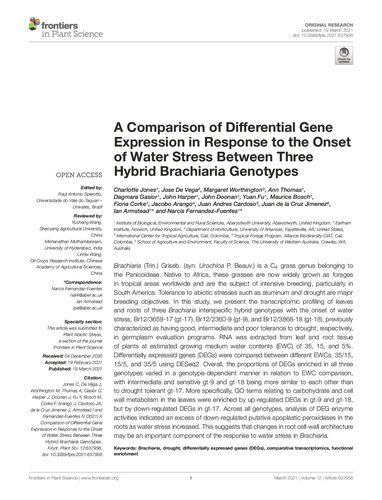A comparison of differential gene expression in response to the onset of water stress between three hybrid Brachiaria genotypes
Brachiaria (Trin.) Griseb. (syn. Urochloa P. Beauv.) is a C4 grass genus belonging to the Panicoideae. Native to Africa, these grasses are now widely grown as forages in tropical areas worldwide and are the subject of intensive breeding, particularly in South America. Tolerance to abiotic stresses such as aluminum and drought are major breeding objectives. In this study, we present the transcriptomic profiling of leaves and roots of three Brachiaria interspecific hybrid genotypes with the onset of water stress, Br12/3659-17 (gt-17), Br12/2360-9 (gt-9), and Br12/3868-18 (gt-18), previously characterized as having good, intermediate and poor tolerance to drought, respectively, in germplasm evaluation programs. RNA was extracted from leaf and root tissue of plants at estimated growing medium water contents (EWC) of 35, 15, and 5%. Differentially expressed genes (DEGs) were compared between different EWCs, 35/15, 15/5, and 35/5 using DESeq2. Overall, the proportions of DEGs enriched in all three genotypes varied in a genotype-dependent manner in relation to EWC comparison, with intermediate and sensitive gt-9 and gt-18 being more similar to each other than to drought tolerant gt-17. More specifically, GO terms relating to carbohydrate and cell wall metabolism in the leaves were enriched by up-regulated DEGs in gt-9 and gt-18, but by down-regulated DEGs in gt-17. Across all genotypes, analysis of DEG enzyme activities indicated an excess of down-regulated putative apoplastic peroxidases in the roots as water stress increased. This suggests that changes in root cell-wall architecture may be an important component of the response to water stress in Brachiaria.

